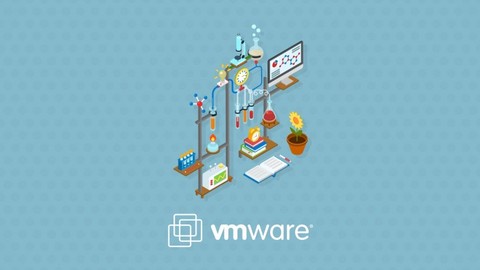
VMWare Professional vSphere 6.7 Exam – VCP-DCV (2V0-21.19)
VMWare Professional vSphere 6.7 Exam – VCP-DCV (2V0-21.19) Practice Tests covering all sections and objectives
- Get prepared for taking the VMWare Professional vSphere 6.7 Exam 2019 – VCP-DCV 2020 exam
- Consolidate VMWare vSphere knowledge
- Preferably six to twelve months hands-on experience installing, configuring, and managing a vSphere solution
- Skills in deploying and administering guest operating systems on a vSphere infrastructure
- Basic knowledge of storage, networking, hardware, security
- Basic knowledge of business continuity and disaster recovery concepts
- Basic knowledge of Operating Systems
- Basic knowledge of environmental monitoring and troubleshooting
VMWare Professional vSphere 6.7 Exam – VCP-DCV (2V0-21.19) Practice Tests
*One test contains only 50 questions (instead of the official 70 questions) and the time limit is 90 minutes (instead of the official 115 minutes)*
*The minimum score to pass is 70%*
*Answers have been curated and official reference resources have been provided*
Mixed set of questions covering all sections and objectives of the 2V0-21.19 exam, seen below:
Sections Included in the Practice Tests
Section 1 – VMware vSphere Architectures and Technologies
- Objective 1.1 – Identify the pre-requisites and components for vSphere implementation
- Objective 1.2 – Identify vCenter high availability (HA) requirements
- Objective 1.3 – Describe storage types for vSphere
- Objective 1.4 – Differentiate between NIOC and SIOC
- Objective 1.5 – Manage vCenter inventory efficiently
- Objective 1.6 – Describe and differentiate among vSphere, HA, DRS, and SDRS functionality
- Objective 1.7 – Describe and identify resource pools and use cases
- Objective 1.8 – Differentiate between VDS and VSS
- Objective 1.9 – Describe the purpose of cluster and the features it provides
- Objective 1.10 – Describe virtual machine (VM) file structure
- Objective 1.11 – Describe vMotion and Storage vMotion technology
Section 2 – VMware Products and Solutions
- Objective 2.1 – Describe vSphere integration with other VMware products
- Objective 2.2 – Describe HA solutions for vSphere
- Objective 2.3 – Describe the options for securing a vSphere environment
Section 3 – There are no testable objectives for this section.
Section 4 – Installing, Configuring, and Setting Up a VMware vSphere Solution
- Objective 4.1 – Understand basic log output from vSphere products
- Objective 4.2 – Create and configure vSphere objects
- Objective. 4.3 – Set up a content library
- Objective 4.4 – Set up ESXi hosts
- Objective 4.5 – Configure virtual networking
- Objective 4.6 – Deploy and configure VMware vCenter Server Appliance (VCSA)
- Objective 4.7 – Set up identity sources
- Objective 4.8 – Configure an SSO domain
Section 5 – Performance-tuning and Optimizing a VMware vSphere Solution
- Objective 5.1 – Determine effective snapshot use cases
- Objective 5.2 – Monitor resources of VCSA in a vSphere environment
- Objective 5.3 – Identify impacts of VM configurations
Section 6 – There are no testable objectives for this section.
Section 7 – Administrative and Operational Tasks in a VMware vSphere Solution
- Objective 7.1 – Manage virtual networking
- Objective 7.2 – Manage datastores
- Objective 7.3 – Configure a storage policy
- Objective 7.4 – Configure host security
- Objective 7.5 – Configure role-based user management
- Objective 7.6 – Configure and use vSphere Compute and Storage cluster options
- Objective 7.7 – Perform different types of migrations
- Objective 7.8 – Manage resources of a vSphere environment
- Objective 7.9 – Create and manage VMs using different methods
- Objective 7.10 – Create and manage templates
- Objective 7.11 – Manage different VMware vCenter Server objects
- Objective 7.12 – Setup permissions on datastores, clusters, vCenter, and hosts
- Objective 7.13 – Identify and interpret affinity/anti affinity rules
- Objective 7.14 – Understand use cases for alarms
- Objective 7.15 – Utilize VMware vSphere Update Manager (VUM)
- Objective 7.16 – Configure and manage host profiles
- System Administrators
- VMWare Administrators
- VMWare Engineers
- System Engineers



